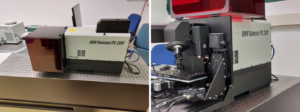Inelastic Ultraviolet Scattering with fixed-energy sources (IUVS-Offline)
Elettra Sincrotrone Trieste

UV Resonance Raman (UVRR) spectroscopy is a very valuable tool for collecting chemically specific information about a large variety of systems thanks to the simultaneous coupling of electromagnetic radiation with the electronic charge localized in particular chromophoric groups of molecules. This second-order coupling is extraordinarily sensitive to molecular structure and environment making UVRR a very high-information content spectroscopy. The high selectivity and the increment of the resonance Raman cross section for vibrations localized within specific chromophoric groups that are excited in the sample enable trace detection methodologies, non-invasive study of structure and dynamics of soft matter, molecular liquids, biological systems under physiological conditions, analysis of electronic properties of nanostructures and strongly correlated materials, characterization of microheterogeneous systems for diagnostic purposes, real-time monitoring chemical reactions for catalysis, analysis of materials of interest for cultural heritage and investigation of graphene-related systems.
Technical specifications
The UVRR setups available on IUVS-Offline enable to perform UV Resonance Raman spectroscopy experiments using fixed-energy laser sources emitting at 213, 224 and 266 nm, both with macro- and micro-sampling mode. Moreover, a fully Integrated, Lab Model, Deep UV Resonance Raman & Photoluminescence Spectrometer (excitation wavelength at 248 nm), with microscopic imaging is available on IUVS-Offline. The instrument (DUV Raman PL 200, Photon Systems) allows to collect DUV excited Raman and photoluminescence spectra and spectral maps of a large variety of samples. The system is equipped with a cuvette holder and a flow cell for liquids analysis and a sample cooling stages for measurements in the range of temperature from -180 to 600 °C.
Information for users
We invite users and collaborators to discuss their proposals with the beamline local contacts well in advance before the submission deadline. This is crucial for a careful assessment of the experiment feasibility and may lead to improvements in the proposed experimental plan. In a restricted number of cases, when doubts arise about the suitability of your samples (sample absorption etc), it may be possible for you to arrange a test.
Contacts:
Tel: +39 040 375 8093 (office) | +39 040 375 8726/8716 (beamline)
Tel: +39 040 375 8042 (office) | +39 040 375 8726/8716 (beamline)
Tel: +39 040 375 8837 (office) | +39 040 375 8726/8716 (beamline)
For more detailed information visit the beamline’s main homepage.



